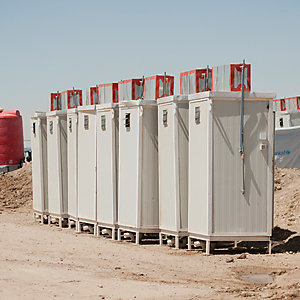ISO 30500, Non-sewered sanitation systems – Prefabricated integrated treatment units – General safety and performance requirements for design and testing, seeks to provide general safety and performance requirements for the product design and performance testing of non-sewered sanitation systems for prefabricated integrated treatment units. It will apply to any integrated sanitation system1) that is not attached to a sewer.
In an integrated system like the ones covered by ISO 30500, the frontend collects, conveys and fully treats the specific input within the non-sewered sanitation system, to allow for safe reuse or disposal of the generated solid, liquid and gaseous output. The crucial distinction of this International Standard is that the backend is not connected to a networked sewer system.
ISO 30500 will contain criteria for the safety, functionality, usability, reliability and maintainability of non-sewered sanitation systems, as well as the system’s compatibility with environmental protection goals. It excludes guidelines for selection, installation, operation and maintenance procedures, or management of non-sewered sanitation systems, and neither incorporates nor substitutes for manufacturers’ instructions and user manuals.
Non-sewered sanitation systems can be used in a number of different places around the world. These include urban and rural communities without access to sewer systems and urban communities pursuing sustainable sanitation solutions. They are suitable for use in temporary or permanent settlements, including refugee camps, and are equally suited to both public or private use in isolated locations.
Improving public health is just the beginning
It’s a straightforward fact that human waste contains numerous germs. As the perfect habitat for bacteria, viruses, fungi, worms and other pathogens, human waste needs to be treated carefully to avoid risks to health. The outputs of sanitation systems that meet ISO 30500’s requirements will be free of these pathogens; thus the standard will help protect individuals, communities and resources such as drinking water from pollution and outbreaks of potentially lethal diseases.
It additionally enables the development of stand-alone non-sewered sanitation systems that promote economic, social and environmental sustainability. This can be achieved by minimizing resource consumption (particularly water use) and enabling the production of useful by-products, such as liquid and solid nutrients, water for reuse, material for the generation of fuel and other reusable outputs, depending on the system.
Benefits for manufacturers
In general, International Standards are strategic tools that reduce costs by minimizing waste and errors, increasing productivity and facilitating free and fair global trade. ISO 30500 will give assurance to manufacturers of non-sewered sanitation systems, governments, regulators and end users that the non-sewered facilities they use are safe, reliable and of good quality.
With the publication of ISO 30500, manufacturers of non-sewered sanitation systems gain from the wide range of well-established benefits that International Standards bring. First among these is the time and resource savings that go with following a tried-and-tested formula agreed to by industry experts. Once the fundamentals have been taken care of, it leaves more time for further development of the features that really make a product stand out in the marketplace.
Creating a level playing field among manufacturers has the twofold advantage of reassuring consumers and stimulating competitive innovations on a technically solid, industry-wide base. At the same time, International Standards are a great facilitator of cross-border trade, as they provide an internationally recognized system that favours compatibility and consistency while giving customers the reassurance of the ISO name. That same recognition is also a help when it comes to marketing, since the ISO brand is trusted the world over.
In a sector where regulations may vary significantly by country, or even municipality, manufacturers can feel more secure with their innovation, research and development in sanitation systems. If they so choose, they can promote their systems towards the public, users and clients as being ISO 30500 certified.
Better policy for user protection
The new standard can also provide a sound basis for the development of national or local regulation for non-sewered systems. That’s because, in common with all ISO standards, ISO 30500 represents best practices and reflects the consensus of regulators, manufacturers and users from across the world. That makes International Standards a useful resource when developing regulations, and gives regulators the benefit of the consolidated opinion of experts without having to call on their services directly. It will enable regulators and government to tap into a constantly updated source of information and experiences.
And more than anyone else, it’s toilet users in non-sewered areas who are going to experience the widest benefits. The requirements of the standard will drive innovation, meaning better toilets will be available in areas where infrastructure such as plumbing and electricity are not feasible. In homes and communities, users of toilets that conform to the standard can be sure their non-sewered sanitation systems will be reliable, safe, hygienic, odour-free, and may even produce by-products that can be reused by the community. When this happens, everyone wins!
Developed by experts
Experts from 31 countries worldwide representing a broad range of stakeholder categories, such as industry, government, academia and non-governmental organizations, have come together to form consensus on the standard. The draft of ISO 30500 was prepared by ISO/PC 305, the project committee on non-sewered sanitation systems, with two liaison organizations, the African Water Association (AfWA) and the Toilet Board Coalition (TBC), also contributing to the standard’s development.
ISO 30500 is expected to be published in 2018.
1) Defined as comprising both frontend (“toilet facility”) and backend (“treatment facility”) elements.

